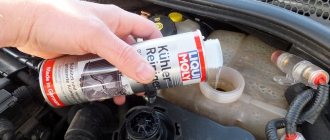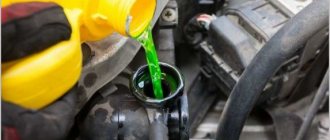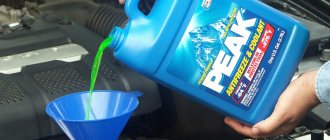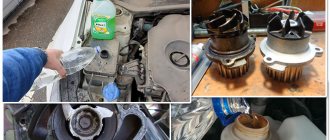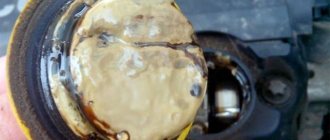Coolant selection
Before you begin replacing consumables, you need to determine the appropriate composition. Antifreeze brands G11, G12, G12+, G13 and others are available for sale, which differ significantly in properties. The compositions interact with each other differently, so during the next maintenance it is recommended to choose a fluid of the same class that was used previously or is indicated in the service book for the car. Universal multi-freezes are also produced, which are fully compatible with coolant of most other brands. The production of such materials is carried out by the company SINTEC Lubricants. MultiFreeze series fluids are suitable for almost all car models, regardless of engine type and design features of the cooling system.
Diagnostics of the system before filling
Before you start replacing the coolant, you should carefully check the cooling circuit. If the level of antifreeze in the expansion tank drops during vehicle operation, this may indicate a possible leak. After adding new fluid, the problem will not disappear; as a result, you will have to regularly replenish the coolant supply and spend additional money on this. Leaks can occur in different nodes. More often, liquid seeps through loose cooling pipes that are attached to the radiator, engine and pump. Antifreeze can also escape through a faulty water pump, in which the sealing elements (seals) have deteriorated. Less commonly, leaks occur due to extensive corrosion of radiators. Another reason is a faulty heater in the car. In the latter case, the liquid may leak directly into the passenger compartment, and puddles may appear under the driver and front passenger mats.
Antifreeze level monitoring
To do this, several methods are used:
- Monitoring the indicator on the instrument panel.
- Monitoring the coolant level directly in the expansion tank.
Under standard operating conditions, this should be done once a month and always before a long trip. If an overheating signal appears on the parting panel while on the road, this problem sometimes occurs due to insufficient antifreeze levels in the system. In winter, this can be indicated by slow heating and poor-quality operation of the stove.
Having noticed non-standard behavior of the power unit regarding the temperature regime of its operation, you need to visit a service station to diagnose the system, since operation during overheating is fraught with deformation of many parts of the internal combustion engine. Understanding how to properly pour and top up antifreeze into the cooling system will help the driver protect the engine from overheating.
What to do before adding fresh antifreeze
Replacing the coolant begins with draining the old antifreeze. This procedure can be performed in different ways, depending on the design features of the car. As a rule, coolant is drained through a special tap located at the bottom of the radiator. To do this, the car must be placed on a pit, overpass or lift in order to be able to place a container of sufficient size under the car. If this is not possible, you can place a wide basin with low walls under the car, which will not rest against the bottom, oil sump and other parts. In some cases, it is also necessary to drain the remaining coolant from the cylinder block in the engine. This will completely clear the circuit of old antifreeze and avoid the consequences that may arise when mixing a new composition and waste fluid.
Preventative flushing of the circuit
If the coolant in the car has not been changed for a long time for any reason, it is recommended to flush the system when replacing it. For this, ordinary distilled water can be used, which is poured after removing the old antifreeze from the circuit. If desired, you can add special flushing agents to it, which are available for sale in many car dealerships. Flushing the system in this way should be done with the engine running. After the engine has run for several minutes, distilled water is drained from the radiator and cylinder block. After this, you can pour in fresh coolant.
Problems when filling antifreeze
Filling directly into the expansion tank is only possible under certain conditions. This can be done if the tank is installed above the radiator filler neck. If the container is at the same level with it, when pouring into the tank, the liquid will not flow into the system by gravity. As a result, the expansion tank may fill, but the coolant will not enter the radiator and engine. This can be understood by the amount of liquid that was poured into the tank. If, according to technical regulations, the system should contain, for example, 5 liters of coolant, but less than one liter was poured through the expansion tank, this means that this method is not applicable. In this case, antifreeze must be poured through the radiator neck.
How to add antifreeze correctly?
Any addition of antifreeze and other refrigerants to the cooling system occurs only through the opening of the expansion tank.
To do this, you need to remove the cap and check for the presence of liquid. The minimum level should be alarming, and the maximum over the course of a month is beyond the norm, so it is better that there is a golden mean.
As mentioned above, you can only add antifreeze with the same composition, regardless of color, but it is better to use the same manufacturer, since there are differences in additives even for completely identical coolants, depending on the batch.
Topping up is carried out most often in the winter season. This is associated with the loss of fluid during cooling and heating (idling car, starting at idle). Such additions are normal and should not be alarmed. If antifreeze consumption becomes high, and a system check shows no malfunctions, then you should consider changing the refrigerant with a more resistant formula to freezing and expansion.
How much antifreeze to pour into the system
When replacing coolant, follow the vehicle manufacturer's recommendations. Exact information about the volume of antifreeze in the circuit should be indicated in the service book for the car. Only minor deviations from the recommended amount of coolant are allowed. It is important that its level in the expansion tank is strictly between the Min and Max marks, which are marked on its body. Exceeding the maximum level risks the fact that when heated, the expanding liquid will create excess pressure in the circuit, which can lead to depressurization, rupture of hoses, breakdown of the radiator and other consequences. Antifreeze can also be squeezed out through the tank or radiator cap, which is extremely undesirable. Lack of coolant in the circuit is no less dangerous. If the amount of antifreeze is insufficient, the performance of the cooling system is reduced, which can lead to overheating of the engine.
You may be interested in: How much antifreeze to pour into the cooling system
Replacing antifreeze
You can replace the coolant without outside help; you just need to take into account some features of the procedure in order not to damage the radiator and engine. It is worth noting that replacement should only occur when the engine is cold.
.
Preliminary steps before adding antifreeze:
- under the hood, the radiator or tank cap is removed;
- the drain plug is unscrewed, the remaining antifreeze is drained into a substitute bucket;
- It is imperative to inspect all system hoses. If there are damages or cracks, replace them;
- Before pouring new antifreeze into the cooling system, it is necessary to flush it and clean it of rust or deposits. It is worth noting that plain water will not cope with this task, so it is recommended to use special substances.
Cleaning the expansion tank or radiator
Cleaning agents are poured into the radiator, purified water is added inside the tank. Close the lids tightly and turn on the engine until it warms up completely. By turning off the engine and allowing it to cool, the residues are drained. Next, water is poured in again, the lids are closed, and the motor is turned on. After 15 minutes, you can turn off the motor and wait for it to cool down. When the engine cools down, the water needs to be drained. The new cooler can now be used. Recommendations from specialists or the manufacturer, which are indicated in the technical documentation for each vehicle, will help you fill in the coolant correctly.
Pouring Tips
- For convenience, you can place the watering can in the expansion tank or radiator.
- It is necessary to fill the coolant extremely correctly to prevent the formation of an air lock in the tank, which can negatively affect the quality of work. It is recommended to pour slowly and intermittently so that the substance is evenly distributed.
- The expansion tank has special marks for minimum and maximum fill; it is first recommended to fill it before the liquid reaches the first mark.
- Close the filler neck cap tightly.
- Start the engine for a few minutes, while monitoring the movement of the coolant in the tank.
- Antifreeze is added to the cooling system to the minimum level.
- Start the engine again and warm it up to operating temperature, while the driver must clearly monitor how the fan operates and check the coolant level.
- After a few days of using the car, add antifreeze as needed to the required level.
Precautionary measures
By being careful and following the instructions, you can change the coolant yourself. If the engine has not cooled down, you cannot completely open the filler cap, because the residual pressure will release liquid at a temperature of up to one hundred degrees, which can lead to burns of varying severity.
After filling, some time may pass, the antifreeze may change its color, you should not be afraid of this.
The color is determined by the dye, which does not affect the quality and performance of the car. And if during the inspection the driver finds traces of corrosion in it, then it is necessary to urgently contact the service center.
Thus, everyone understands that replacing the coolant does not require special knowledge or skills
, it is enough to be guided by the technical characteristics of the machine’s service book, be careful and careful. By changing the cooler yourself, the car enthusiast will learn to more carefully monitor its operation and understand when it is necessary to repeat the procedure. The durability of a car depends on how much the owner takes care of it; every little detail matters. Have a nice and safe trip!
← Previous material
Next material →
What to do after replacing the coolant
In the next few days after adding fresh antifreeze, you should periodically check the coolant level in the tank and inspect the engine compartment for the presence or absence of leaks. During this period, the amount of liquid in the expansion tank may decrease slightly; this is considered normal. The fact is that after replacing the coolant, the channels inside the cooling circuit are gradually filled. This requires a certain amount of antifreeze. When all working channels in the system are finally filled with liquid, its level in the expansion tank stabilizes and remains at the same level. As a rule, this takes 1–3 days depending on the operating mode of the vehicle.
When to add antifreeze to the cooling system
First, let's figure out the required frequency of adding antifreeze, as well as when exactly this needs to be done. There are several reasons for adding coolant:
- The fluid level in the system has dropped noticeably . This can happen due to leaks in the system. Hyundai Solaris, for example, has two marks L and F on the expansion tank, indicating low and high levels, respectively. If the fluid level drops below the L mark, the required amount of antifreeze must be added. On different cars, the marks may be designated differently, but the meaning remains the same.
- The fluid level suddenly dropped after a recent top-up . This happens due to a leak, the location of which in the system must be found.
- The refrigerant has expired . Let's take the Hyundai Solaris as an example again. You need to pour fresh antifreeze into this car, guided by the service life of the existing fluid: for class G-11 this period is from 2 to 3 years, for class G-12 - up to 5 years, for higher classes - over 5 years. But no one forbids changing the coolant more often if the poured mixture has thickened, darkened and no longer fulfills its functions - the engine constantly overheats. This happens if a low-quality or counterfeit product was poured into the system.
In some cases, the expansion tank release valve may periodically operate. This clearly signals that the antifreeze has not lost its qualities and does not remove heat. You need to drain the old fluid and fill in new one.
In some car models, a low coolant level can also be indicated by a separate indicator on the dashboard. To check the coolant level, the car must be placed on a horizontal surface.
It should be borne in mind that with a small amount of antifreeze in the system, it begins to experience increased thermal loads, and therefore quickly loses its performance properties and does not always cope with the assigned task. The result is frequent engine overheating, increased oil consumption and other troubles.
Let’s finish with the theory and move directly to practical advice on how to pour antifreeze into a car.
Where to replace
It is recommended to carry out work related to the maintenance of the vehicle cooling system in specialized car services. In the absence of the necessary experience and knowledge, a number of serious mistakes can be made in the process of replacing the coolant. This can lead to various consequences. Firstly, incomplete draining of the old composition risks the fact that fresh antifreeze will mix with the remnants of the used coolant and quickly lose its performance properties. Secondly, the used liquid must be properly disposed of. All the necessary conditions for this are available only in specialized services. Used antifreeze should not be bottled and thrown into regular trash cans, as this causes great damage to the environment.
Benefits of using multifreeze
If you plan to replace the coolant, you should pay attention to the products of SINTEC Lubricants. The company produces high-quality multifreezes that have high performance characteristics and can be mixed with other types of coolant. The composition includes special protective additives that prevent corrosion of aluminum, copper and brass cooling radiators, thereby increasing their trouble-free operation. An important feature of MultiFreeze coolant is that the material is designed for the entire period of operation of the vehicle. Multifreeze does not need to be regularly changed every 2–5 years. The coolant retains its original properties (thermal conductivity, anti-corrosion characteristics, protection against cavitation) for a long time, which significantly reduces the cost of vehicle maintenance.
#Advice from experts
You may also be interested
Use of antifreeze in northern regions
In many regions of our country, periods with negative temperatures prevail over the warm season of the year. In such conditions, operating cars presents certain difficulties for car owners: it is necessary to carefully select technical fluids, and in particular antifreeze. The modern Russian auto chemical market is flooded with a variety of products; the driver only has to choose a coolant that will work effectively under intense loads, […]
What antifreezes can be mixed: compatibility table
In some situations, it becomes necessary to combine different cooling compounds. Liquids have to be mixed, for example, when you need to add the missing amount of coolant to the system in case of unexpected breakdowns on the road. To extend the service life of cooling system components, you need to study in advance information about the compatibility of different compositions.
Is it possible to add water to antifreeze?
To find out whether it is possible to dilute the coolant with water, you should study the composition of the antifreeze. Its base (about 90%) is ethylene glycol or propylene glycol. This is a dihydric alcohol, in its pure form it is an oily substance. The boiling point is +200°C. It freezes at -12.3°C.
There is water there too. Its share is 3-5%. Distillate is added during production. The remaining 5-7% comes from additives. It is they that distinguish all types of coolant; it is the additives that affect the duration and quality of engine service.
